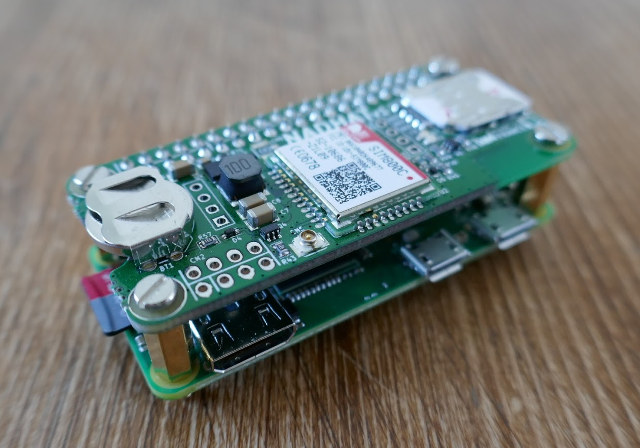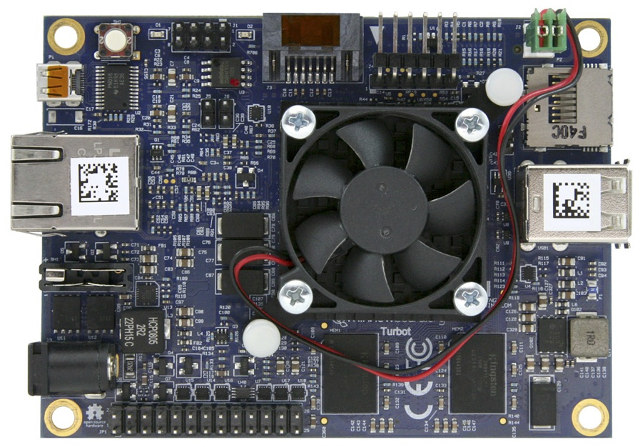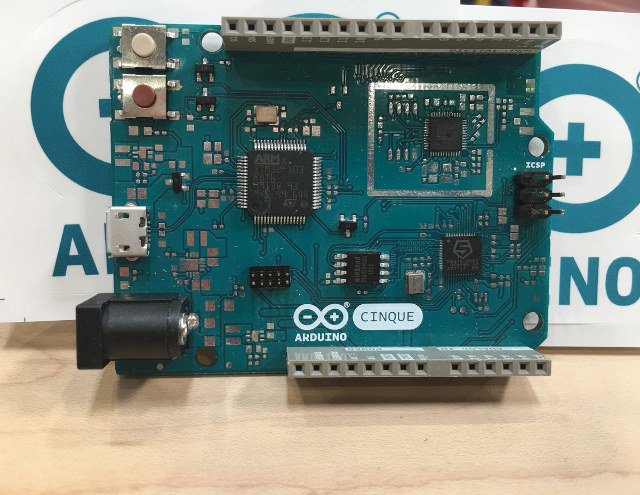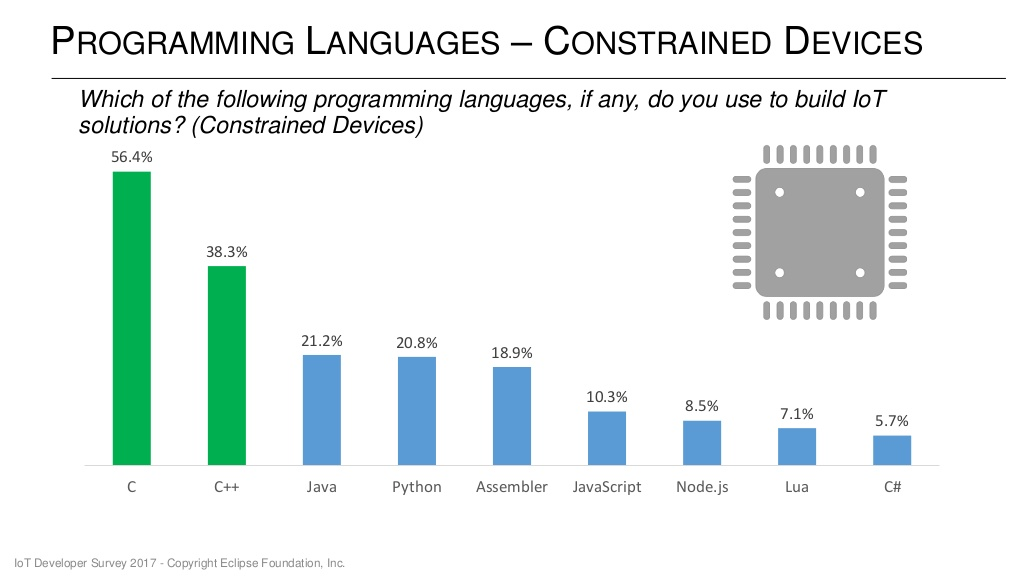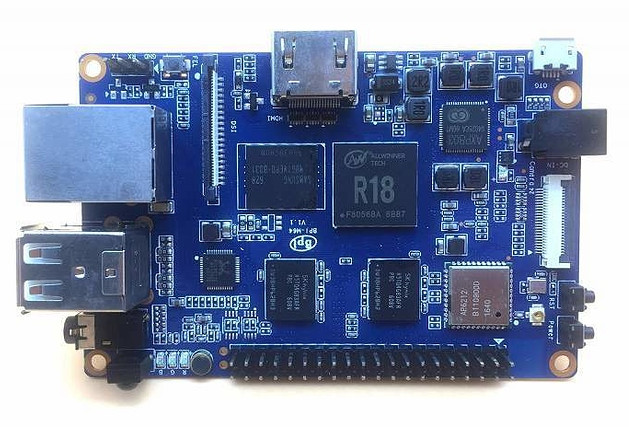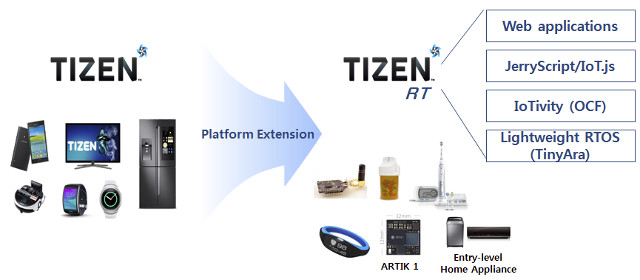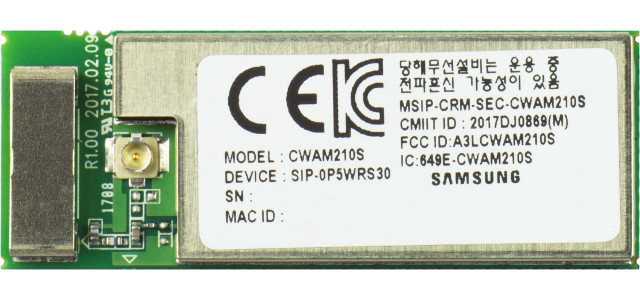Making Raspberry Pi HATs for fun seems to have become a popular hobby, as after checking out Leon Anavi’s Infrared pHAT a little while ago, I’ve just come across Nadhat add-on board with GSM/GPRS and Bluetooth 3.0 made by Frederic Pierson in his spare time. Nad stands for “Network Access Device”, and the device comes with the following specifications: SIM800C module with 2G GSM/GPRS support, and Bluetooth 3.0 + EDR (but Bluetooth is not mentioned by the developer, so it may not work right now) SIM card slot + connector for GSM antenna CR1225 cell battery slot for RTC 40-pin header provided, but not soldered Dimensions – 65 x30 mm, compatible with Raspberry Pi Zero He explains that he made the board himself and the PCBs “are leaded reflow processed and do not follow regulations in Europe”. You’ll also have to provide your own GSM antenna and CR1225 battery. He’s […]
MinnowBoard Turbot Quad Core Open Source Hardware Board is now Shipping for $190
MinnowBoard Turbot Quad Core board was announced last autumn, with shipping expected in December 2016, but there may have been delays as the MinnowBoard foundation has just announced that the Intel open source hardware board is now shipping. MinnowBoard Turbot Quad “MBT-4220” board specifications: SoC – Intel Atom E3845 quad core Bay Trail-I processor @ up to 1.92 GHz with Intel HD graphics @ 542 / 792 MHz (10W TDP) System Memory – 2GB DDR3L 1067 MT/s (Soldered) Storage – 1x SATA2 3Gbps, 1x micro SD card slot, 8 MB SPI Flash for firmware (Tianocore UEFI, Coreboot, SeaBIOS) Video & Audio Output – 1x micro HDMI connector Connectivity – 10/100/1000M Ethernet RJ-45 connector (with Intel i211 instead of Realtek NIC on dual core MinnowBoard) USB – 1x USB 3.0 host, 1x USB 2.0 host Debugging – Serial debug header Expansion headers Low-speed expansion (LSE) port – 2×13 (26-pin) male 0.1″ […]
8Power Vibration Energy Harvesting Technology Powers Batteryless LPWAN GPS Trackers, MEMS Sensors
While IoT products usually promises one to 10 years battery life, they will be several billions of them, and ARM’s CEO even forecast one trillion IoT devices in the next 20 years. Recharging batteries at home may be fine, but imagine having to recharge or replace batteries on top of electric poles, inside walls, in remote locations, and other hard to reach places, considerable resources would have to be deployed just to replace or recharge battery every year or whenever the battery is close to being depleted. That’s why work on energy harvesting technology for batteryless devices may be so important, and 8Power is one of the companies working in the field through their vibration energy harvesting technology that is said to harvest up to 10x the power of competing devices under comparable condition thanks to the use of parametric resonance phenomenon. The company has recently announced their Track 100 family […]
Arduino Cinque Combines SiFive RISC-V Freedom E310 MCU with ESP32 WiFi & Bluetooth SoC
SiFive introduced the first Arduino compatible board based on RISC-V processor late last year with HiFive1 development board powered by Freedom E310 MCU, but the company has been working with Arduino directly on Arduino Cinque board equipped with SiFive Freedom E310 processor, ESP32 for WiFi and Bluetooth, and an STM32 ARM MCU to handle programming. Few other technical details have been provided for the new board, but since it looks so similar to HiFive1, I’ve come with up with preliminary/tentative Arduino Cinque specifications: MCU – SiFive Freedom E310 (FE310) 32-bit RV32IMAC processor @ up to 320+ MHz (1.61 DMIPS/MHz) WiSoC – Espressif ESP32 for WiFi and Bluetooth 4.2 LE Storage – 32-Mbit SPI flash I/Os 19x Digital I/O Pins 19x external interrupt pins 1x external wakeup pin 9x PWM pins 1/3 SPI Controllers/HW CS Pins I/O Voltages – 3.3V or 5V supported USB – 1x micro USB port for power, […]
Top Programming Languages & Operating Systems for the Internet of Things
The Eclipse foundation has recently done its IoT Developer Survey answered by 713 developers, where they asked IoT programming languages, cloud platforms, IoT operating systems, messaging protocols (MQTT, HTTP), IoT hardware architectures and more. The results have now been published. So let’s have a look at some of the slides, especially with regards to programming languages and operating systems bearing in mind that IoT is a general terms that may apply to sensors, gateways and the cloud, so the survey correctly separated languages for different segments of the IoT ecosystem. C and C++ are still the preferred languages for constrained devices, and developers are normally using more than one language as the total is well over 100%. IoT gateways are more powerful and resourceful (memory/storage) hardware, so it’s no surprise higher level languages like Java and Python join C and C++, with Java being the most used language with 40.8% […]
Banana Pi BPI-M64 Board Gets Allwinner R18 Processor with Google Cloud IoT Core Support
Banana Pi BPI-M64 board was launched with Allwinner A64 processor, but a few days ago, I noticed the board got an option for Allwinner R18. Both processors are likely very similar since they are pin-to-pin compatible, and Pine64 was first seen with Allwinner R18, so I did not really feel it was newsworthy. But today, Google announced Google Cloud IoT Core cloud service working with a few app partners such as Helium and Losant, as well as several device partners including ARM, Marvell, Microchip, Mongoose OS, NXP… and Allwinner, having just announced the release of an Allwinner R18 SDK with libraries supporting Google Cloud IoT Core. Let’s go through the board specifications first which are exactly the same as for the original BPI-M64 board, except for the processor: SoC – Allwinner R18 quad core ARM Cortex A53 processor with Mali-400MP2 GPU System Memory – 2GB DDR3 Storage – 8GB eMMC […]
Samsung Unveils Tizen 4.0 with .NET Framework, Low End IoT Devices Support
We’ve already seen the announcement of Samsung ARTIK 053 WiFi module with Tizen RT this morning, but it appears that Tizen RT (Real Time) is part of a Tizen 4.0 that will add support to IoT devices, as well as introduce changes from the developers’ perspective. Samsung Electronics talked a bit more about Tizen Next (Tizen 4.0) at the Tizen Developer Conference (TDC) 2017 taking in place on May 16-17 in San Francisco. Few details are provided in the press released, but we could learn that “the Tizen 4.0 platform has been extended to Tizen RT (Real-Time) to involve high-end products such as TVs and mobile devices as well as low-end products such as thermostats, scales, bulbs, and more”. Tizen RT page explains that the real-time operating system is designed to run on Cortex M/R MCU with less than 2 MB RAM, less than 16 MB flash, and consists of […]
Samsung ARTIK 053 WiFi IoT Module Runs Tizen RT on an ARM Cortex R4 MCU
Samsung has just introduced the latest member of its Artik family at IoT World 2017. ARTIK 053 is a WiFi module powered by an ARM Cortex R4 wireless micro-controller @ 320 MHz with hardware based security, GPIO, SPI, and I2C ports, and running Tizen RT real-time operating system. Artik 053 module specifications: MCU – 32-bit ARM Cortex R4 @ 320MHz with 1280 KB RAM for general use, 128 KB RAM for global IPC data (likely Samsung Exynos i T200, or a variant without an ARM Cortex M0+ core) Storage – 8 MB flash Connectivity – 802.11 b/g/n WiFi @ 2.4 GHz Expansion – 29 dedicated GPIO ports, 2x SPI, 4x UART (2-pin), 4x ADC, 1x JTAG, 2x I2C Security – AES/DES/TDES, SHA-1/SHA-2, PKA (Public Key Accelerator), PRNG/DTRNG (Random Number Generators), Secure key storage, Physical Unclonable Function (PUF) Power Supply – 5 to 12VDC input voltage Dimensions – 40 x 15 x […]


